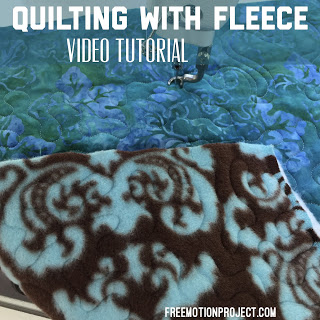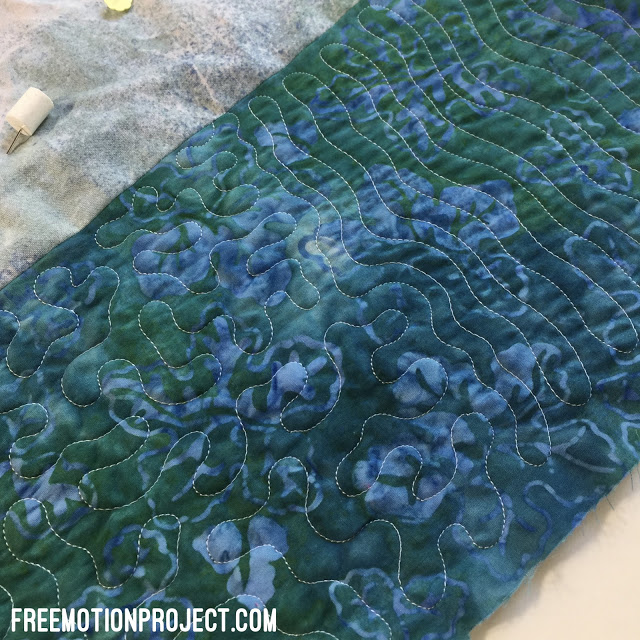How to Quilt with Fleece – Sit Down Quilting #10
Time for a quick Sit Down Quilting video! Last week I was in Hobby Lobby and I saw they had a huge stock of fleece fabric in really pretty colors and designs. It got me wondering how it works to quilt with fleece as your backing fabric. So I bought a few yards and gave it a go!

What’s up with the French Fuse?
Whenever I work with a weird fabric, I always stabilize it first. French Fuse is my preferred stabilizer because it’s lightweight, fuses easily, and you absolutely can’t tell it’s in the quilt after it’s quilted. Click Here to find French Fuse.
My piecer and I found the best way to fuse the French Fuse to fleece was to crank my iron up to high and use a cotton pressing cloth (spare ugly fat quarter laying around) on top of the French Fuse. You need to press slowly over the fabric to ensure a good fuse of the interfacing to the fleece.
Is step this really necessary?
I think so. When basting a quilt, I always like to pull the backing nice and tight to the table top. Fleece is naturally stretchy and if I didn’t stabilize it with French Fuse, it would stretch way out of control during basting.
Then if I layered the batting and quilt top on top and stuck pins through it, more than likely when I removed the tape the fleece would retract back into it’s normal shape, causing my quilt top and batting to go crazy.
I think the better move is to stabilize! The flatter and less stretchy a fabric is, the easier it will be to quilt.
Two Layers or Three?
This was an interesting part of my experiment. I wanted to know if you could skip the batting on a fleece backed quilt and just have the quilt top and fleece. It would be very lightweight and a nice throw blanket for the couch or possibly a good choice for quilted garments.
Well ultimately I found it’s definitely possible to quilt with only two layers: fleece and quilt, but you’re going to have a different texture to your quilt.
You know that crinkly texture you get when you don’t prewash your fabric and you use a 100% cotton batting that shrinks? This finish is a bit more intense than that. It’s super crinkle!

When my employee and I compared the two finishes, we both agreed the quilting stitches looked just as nice on both squares, and the piecer really liked the crinkly feeling. It also hides your quilting design a bit on the surface because the stitches sink further into the fabric.
Personally I like a very flat finish to my quilts so the quilting design shows up nicely on the surface so I liked the square that had thin batting in the middle.

One thing I noticed on both samples is how the individual quilting stitches are almost completely invisible on the fleece side. The fuzzy loft of the fleece completely covers the stitches so you can’t see subtle variation in size of your stitches, just the texture the lines create:

So fleece would be a great choice for your backing fabric if you’re still struggling to maintain a consistent stitch length for free motion quilting. It’s nice to be able to hide the stitches, but not the texture of the design you’ve stitched.
Ultimately I found this to be a really fun test and I can’t wait to try quilting an entire fleece backed quilt. What do you think? Have you ever quilted with fleece as your backing fabric? What do you think of using materials like this in your quilts?
Share your thoughts and experiences in the comments below!
Let’s go quilt,
Leah Day

I love using fleece as an all-in-one backing & batting option for lighter weight quilts I, however, had a huge problem with thread breaking while FMQ with fleece. After MUCH trial and error and searching every quilting board for a solution, I finally came upon a post that recommended using an embroidery needle for FMQ on denser fabrics such as flannel or fleece. Those needles are tempered and resist bending at high speeds and the eye of the needle is polished which helps with thread breaking as well. It might be different for every machine, but if any readers are having a thread break problem, try embroidery needles!
I use fleece all the time and Minkee with 80-20 batting but I have never put a fusing on the fleece. Seems like it might be a lot of extra work and expense.
I sometimes use cuddle fleece on the back of my quilts for a warm cosy feel, but haven't as yet tried free motion quilting on it. Now I am going to experiment. This is perfect timing – your post. Wendi Gratz who did a fusible applique class on Craftsy does the quilt front and quilting just with fabric and batting and then adds the fleece as last step for backing and that worked well too. I love a warm quilt. But I had been wondering no that I am learning free motion from yourself how it would work on the fleece. Yay very happy to read your experiment.
Thank you for your opinion. I'll definitely try it again without the French Fuse.
That's really good to know! Thank you for sharing Lori!
Perfect! I'm so glad this came out at the right time for you!
Great instructions on how to great the fleece ready for free-motion quilting. Worked like a charm. Thank you, Leah, for documenting it so thoroughly!
That’s great Doris! I’m so happy to hear that you enjoyed this tutorial!
How do you recommend “joining” the french fuse when you are using more than one piece for larger projects? Would you overlap the french fuse slightly or just rest them next to each other? Thanks!
Great question Meghan! I overlap the pieces slightly and it works great. The French Fuse material is so lightweight it’s not noticeable on the front or back.
I have made several baby and child sized quilts using a cute panel for the top with borders and fleece for the back. I free motion quilt and follow some of the cute patterns on the front and that way the picture on the panel also shows up on the back with the quilting. It is fun and still soft and cuddly and the kids love them.
That’s wonderful Linda! I’m so happy to hear this!
Tried a two layer fleece quilt today with batting, only did straight lines though for stitches since the top fabric was plaid and wasn’t sure how well free motion would work with it this thick. Had to pull the fabric through a bit. Finished it with self binding, will be a nice warm quilt.
That sounds delightful Stephanie! It will certainly be a super warm quilt!
I quilted a fleece blanket with 2 pieces of fleece. I spray glued them together and it worked pretty well. One fleece had heart designs so I just stitched around the hearts. The fleece was very stretchy but having glued the two fabrics together made them more stable. I know the stitching was not very even but the pile covered that up. My granddaughter loves it.
Wonderful Marla! Great job!
Will it work with both sides in fleece?